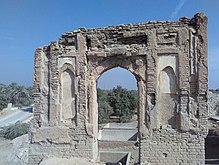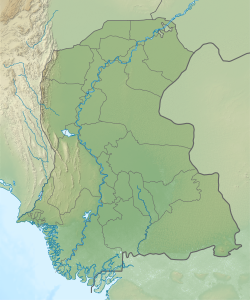Aror
 | |
 Shown within Sindh | |
| Location | Sukkur District, Sindh, Pakistan |
|---|---|
| Coordinates | 27°39′00″N 68°59′00″E / 27.65°N 68.9833°ECoordinates: 27°39′00″N 68°59′00″E / 27.65°N 68.9833°E |
| Type | Settlement |
| History | |
| Abandoned | 9th century BCE |
Aror (Sindhi: اروهڙ) or Alor or Arorkot (Sindhi: اروهڙ ڪوٽ) is the medieval name of the city of Rohri (in Sindh, modern Pakistan).[1] Aror once served as the capital of Sindh.[2][3]
History[]
As Roruka, capital of the Sauvira Kingdom, it is mentioned as an important trading center in early Buddhist literature.[4] Little is known about the city's history prior to the Arab invasion in the 8th century CE.[5] Al-rur was the capital of the Ror Dynasty, which was followed by Rai Dynasty and then the Brahman Dynasty that once ruled northern Sindh.
Aror is the ancestral town of the Arora Community.[6] In 711, Aror was captured by the army of Muslim general Muhammad bin Qasim. Arab historians recorded the city's name as Al-rur, Al-ruhr and Al Ror.[7]
In 962 it was hit by a massive earthquake that changed the course of the Indus River and ruined the town's mud brick building,[8] thereby setting into play the city's decline, and eventual re-settlement at Rohri,[9] along the modern-day shores of the Indus.[10]
Ruins[]
Most of Aror's ruins have been lost, though some arches of a mosque built shortly after the 8th century Arab invasion remain standing.[10] The Kalka Cave Temple, Hindu temple dedicated to Kalkaan Devi still exists near the ruins, and are still used.[10] The Chattan Shah ji Takri shrine is built atop a high rock outside the city, and is traditionally believed to be a companion of Ali, cousin of the Prophet Muhammad.[10]
See also[]
- Aror University of Art, Architecture, Design and Heritages
- Rohri
- Muhammad bin Qasim ath-Thaqafī
Ottomano C. and Biagi P. 1997 - Palaeopedological observations and radiocarbon dating of an archaeological secyion at Aror (Sindh-Pakistan). Ancient Sindh, 4: 73-80
References[]
- ^ Singh, Kumar Suresh; Ghosh, Tapash Kumar; Nath, Surendra (1996). People of India: Delhi. Anthropological Survey of India. ISBN 9788173040962. Retrieved 8 October 2014.
The Arora or Rora is a community of traders of the south-western part of the Punjab. Their origin according to the Bhavishya Purana, can be traced back to the time of Parshuram, who in anger started killing the Kshatriyas. In this process, Parshuram met a Kshatriya who refused to oppose the Brahmans, and winning Parshuram's respect, was asked to go to Sindh to setde there. Later, the place came to be known as Arutkot or Arorkot. His progeny are called Aroras.
- ^ Malhotra, Anshu (2002). Gender, Caste, and Religious Identities: Restructuring Class in Colonial Punjab. Oxford University Press. ISBN 9780195656480. Retrieved 8 October 2014.
The Aroras were also said to be the Khatris of Arorkot, or Aror, the ancient capital of Sindh.
- ^ Handbook of the Punjab, Western Rajputana, Kashmir, and Upper Sindh. John Murray. 1883. p. 293. Retrieved 8 October 2014.
Aror.--While at Rorhi, a visit may be paid to the very ancient town of Aor, which is only 5 m. distant to the E. This was the capital of the Hindu Rajas of Sindh and was taken from them by the Muslims, under Muhammad Kasim, about 711 A.D. At that time the Indus washed the city of , but it was diverted from it by an earthquake about 962 A.D., at which the river entered its present channel.
- ^ Derryl N. MacLean (1989), Religion and Society in Arab Sind, p.63
- ^ Hughes, Albert William (1876). A Gazetteer of the Province of Sind. G. Bell and Sons. p. 677. Retrieved 19 December 2017.
aror .
- ^ Denzil Ibbetson (1970). Panjab Castes, Being a Reprint of the Chapter on "The Races, Castes, and Tribes of the People" in the Report on the Census of the Panjab. Languages Department, Punjab.
- ^ "Alor or Aror of the Muslims is really Al Ror which is the same as Roruka or Roruva, the name of the ancient Sauvira capital", Page 45, History of the Punjab, Volume 1 by Fauja Singh, Published by the Department of Punjab Historical Studies, Punjabi University, 1977
- ^ Rose, H. A (1911). A Glossary of The Tribes & Castes of The Punjab & North West Frontier Province. Vol. II. Lahore: Samuel T. Weston. p. 17. Retrieved 24 October 2011.
- ^ Bowden, Rob (2004). Settlements of the Indus River. Heinemann-Raintree Library. ISBN 1403457182. Retrieved 19 December 2017.
- ^ a b c d "Where the city of Aror once stood in glory". Dawn. Retrieved 19 December 2017.
- Sukkur District
- History of Pakistan
- History of Sindh
- Chach Nama

